Cryptography: Theory and Practice:Authentication Codes
 | Cryptography: Theory and Practice by Douglas Stinson CRC Press, CRC Press LLC ISBN: 0849385210 Pub Date: 03/17/95 |
| Previous | Table of Contents | Next |
Example 10.2
Consider the authentication matrix of Figure 10.4. Suppose the probability distributions on  and
and  are
are

1 ≤ i ≤ 4; and

The values payoff (s, a) are as follows:

Hence, Pd0 = 3/4. Oscar’s optimal impersonation strategy is to place any of the messages (1, 1), (3, 1) or (4, 2) into the channel.
Now we turn to the computation of Pd1. First, we present the various values payoff (s′, a′; s, a) in the form of a matrix. The entry in row (s, a) and column (s′, a′) is the value payoff (s′, a′; s, a).
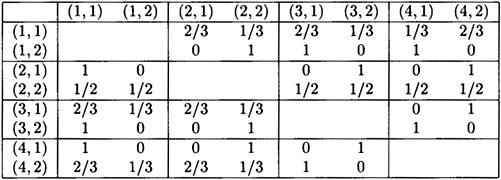
Thus we have p1,1 = 2/3, p2,2 = 1/2, and ps,a = 1 for all other s, a. It is then a simple matter to evaluate Pd1 = 7/8. An optimal substitution strategy for Oscar is as follows:
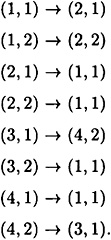
This strategy indeed yields Pd1 = 7/8.
The computation of Pd1 in Example 10.2 is straightforward but lengthy. We can in fact simplify the computation of Pd1 by observing that we divide by the quantity payoff (s, a) in the computation of ps,a, and then later multiply by payoff (s, a) in the computation of Pd1. Of course, these two operations cancel each other out. Suppose we define

for all s, a. Then we have the following more concise formula for Pd1:

10.3 Combinatorial Bounds
We have seen that the security of an authentication code is measured by the deception probabilities. Hence, we want to construct codes so that these probabilities are as small as possible. But other considerations are also important. Let’s consider the various objectives that we might strive for in an authentication code:
- 1. The deception probabilities Pd0 and Pd1 must be small enough to obtain the desired level of security.
- 2. The number of source states must be large enough so that we can communicate the desired information by appending an authentication tag to one source state.
- 3. The size of the key space should be minimized, since the value of the key must be communicated over a secure channel. (Note that the key must be changed every time a message is communicated, as is done with the One-time Pad.)
- 2. The number of source states must be large enough so that we can communicate the desired information by appending an authentication tag to one source state.
In this section, we determine lower bounds on the deception probabilities, which will be computed in terms of other parameters of the code. Recall that we have defined an authentication code to consist of a four-tuple  . Throughout this section, we will denote
. Throughout this section, we will denote  .
.
Suppose we fix a source state  . Then we can compute:
. Then we can compute:
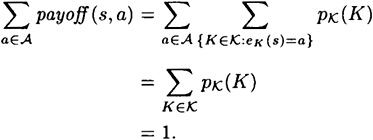
Hence, for every  , there exists an authentication tag a(s) such that
, there exists an authentication tag a(s) such that

The following theorem follows easily.
THEOREM 10.1
Suppose  is an authentication code. Then
is an authentication code. Then  , where
, where  . Further,
. Further,  if and only if
if and only if

for every  .
.
Now, we turn our attention to substitution. Suppose we fix s, a and s′, where s′ ≠ s. Then we have the following:
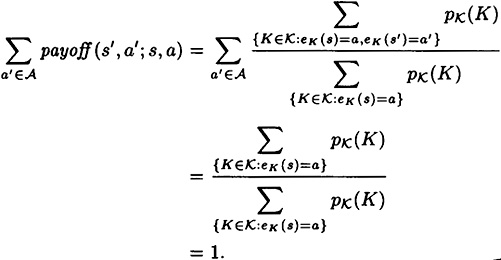
So, there exists an authentication tag a′(s′, s, a) such that

The next theorem follows as a consequence.
THEOREM 10.2
Suppose  is an authentication code. Then
is an authentication code. Then  , where
, where  . Further,
. Further,  if and only if
if and only if

for every  .
.
PROOF We have
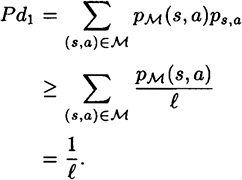
Further, equality occurs if and only if  for ever (s, a). But this is in turn equivalent to the condition that
for ever (s, a). But this is in turn equivalent to the condition that  for every (s, a).
for every (s, a).
Combining Theorems 10.1 and 10.2, we get the following:
THEOREM 10.3
Suppose  is an authentication code, where
is an authentication code, where  . Then
. Then  if and only if
if and only if

for every  .
.
PROOF Equations (10.4) and (10.5) imply Equation (10.6). Conversely, Equation (10.6) implies Equations (10.4) and (10.5).
If the keys are equiprobable, then we obtain the following corollary:
COROLLARY 10.4
Suppose  is an authentication code where
is an authentication code where  , and keys are chosen equiprobably. Then
, and keys are chosen equiprobably. Then  if and only if
if and only if

for every  .
.
10.3.1 Orthogonal Arrays
In this section, we look at the connections between authentication codes and certain combinatorial structures called orthogonal arrays. First, we give a definition.

Figure 10.5 An OA(3, 3, 1)
DEFINITION 10.2 An orthogonal array OA(n, k, λ) is a λn2 × k array of n symbols, such that in any two columns of the array every one of the possible n2 pairs of symbols occurs in exactly λ rows.
Orthogonal arrays are well-studied structures in combinatorial design theory, and are equivalent to other structures such as transversal designs, mutually orthogonal Latin squares and nets.
In Figure 10.5, we present an orthogonal array OA(3, 3, 1) which is obtained from the authentication matrix of Figure 10.3. Any orthogonal array OA(n, k, λ) can be used to construct an authentication code with Pd0 = Pd1 = 1/n, as stated in the following theorem.
THEOREM 10.5
Suppose there is an orthogonal array OA(n, k, λ). Then there is an authentication code  , where
, where  and Pd0 = Pd1 = 1/n.
and Pd0 = Pd1 = 1/n.
PROOF Use each row of the orthogonal array as an authentication rule with equal probability 1/(λn2). The correspondences are as follows:

Since Equation (10.7) is satisfied, we can apply Corollary 10.4, obtaining a code with the stated properties.
| Previous | Table of Contents | Next |
Copyright © CRC Press LLC
EAN: 2147483647
Pages: 133